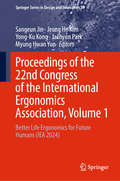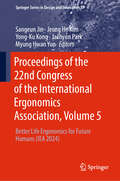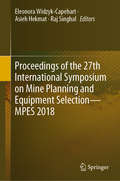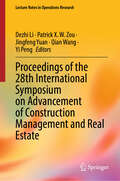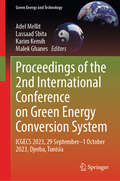- Table View
- List View
Proceedings of the 21st Congress of the International Ergonomics Association: Volume II: Inclusive Design (Lecture Notes in Networks and Systems #220)
by Nancy L. Black W. Patrick Neumann Ian NoyThis book presents the proceedings of the 21st Congress of the International Ergonomics Association (IEA 2021), held online on June 13-18, 2021. By highlighting the latest theories and models, as well as cutting-edge technologies and applications, and by combining findings from a range of disciplines including engineering, design, robotics, healthcare, management, computer science, human biology and behavioral science, it provides researchers and practitioners alike with a comprehensive, timely guide on human factors and ergonomics. It also offers an excellent source of innovative ideas to stimulate future discussions and developments aimed at applying knowledge and techniques to optimize system performance, while at the same time promoting the health, safety and wellbeing of individuals. The proceedings include papers from researchers and practitioners, scientists and physicians, institutional leaders, managers and policy makers that contribute to constructing the Human Factors and Ergonomics approach across a variety of methodologies, domains and productive sectors. This volume includes papers addressing the following topics: Ergonomics in Design for All, Human Factors and Sustainable Development, Gender and Work, Slips Trips and Falls, Visual Ergonomics, Ergonomics for children and Educational Environments, Ageing and Work.
Proceedings of the 21st Congress of the International Ergonomics Association: Volume III: Sector Based Ergonomics (Lecture Notes in Networks and Systems #221)
by Nancy L. Black W. Patrick Neumann Ian NoyThis book presents the proceedings of the 21st Congress of the International Ergonomics Association (IEA 2021), held online on June 13-18, 2021. By highlighting the latest theories and models, as well as cutting-edge technologies and applications, and by combining findings from a range of disciplines including engineering, design, robotics, healthcare, management, computer science, human biology and behavioral science, it provides researchers and practitioners alike with a comprehensive, timely guide on human factors and ergonomics. It also offers an excellent source of innovative ideas to stimulate future discussions and developments aimed at applying knowledge and techniques to optimize system performance, while at the same time promoting the health, safety and wellbeing of individuals. The proceedings include papers from researchers and practitioners, scientists and physicians, institutional leaders, managers and policy makers that contribute to constructing the Human Factors and Ergonomics approach across a variety of methodologies, domains and productive sectors. This volume includes papers addressing the following topics: Transport Ergonomics and Human Factors, Practitioner Case Studies, Human Factors in Robotics, Manufacturing, Agriculture, HF/E in Supply Chain Design and Management, Aerospace, Building and Construction.
Proceedings of the 21st Congress of the International Ergonomics Association: Volume IV: Healthcare and Healthy Work (Lecture Notes in Networks and Systems #222)
by Nancy L. Black W. Patrick Neumann Ian NoyThis book presents the proceedings of the 21st Congress of the International Ergonomics Association (IEA 2021), held online on June 13-18, 2021. By highlighting the latest theories and models, as well as cutting-edge technologies and applications, and by combining findings from a range of disciplines including engineering, design, robotics, healthcare, management, computer science, human biology and behavioral science, it provides researchers and practitioners alike with a comprehensive, timely guide on human factors and ergonomics. It also offers an excellent source of innovative ideas to stimulate future discussions and developments aimed at applying knowledge and techniques to optimize system performance, while at the same time promoting the health, safety and wellbeing of individuals. The proceedings include papers from researchers and practitioners, scientists and physicians, institutional leaders, managers and policy makers that contribute to constructing the Human Factors and Ergonomics approach across a variety of methodologies, domains and productive sectors. This volume includes papers addressing the following topics: Healthcare Ergonomics, Health and Safety, Musculoskeletal Disorders, HF/E Contribution to cope with Covid-19.
Proceedings of the 21st Congress of the International Ergonomics Association: Volume V: Methods & Approaches (Lecture Notes in Networks and Systems #223)
by Nancy L. Black W. Patrick Neumann Ian NoyThis book presents the proceedings of the 21st Congress of the International Ergonomics Association (IEA 2021), held online on June 13-18, 2021. By highlighting the latest theories and models, as well as cutting-edge technologies and applications, and by combining findings from a range of disciplines including engineering, design, robotics, healthcare, management, computer science, human biology and behavioral science, it provides researchers and practitioners alike with a comprehensive, timely guide on human factors and ergonomics. It also offers an excellent source of innovative ideas to stimulate future discussions and developments aimed at applying knowledge and techniques to optimize system performance, while at the same time promoting the health, safety and wellbeing of individuals. The proceedings include papers from researchers and practitioners, scientists and physicians, institutional leaders, managers and policy makers that contribute to constructing the Human Factors and Ergonomics approach across a variety of methodologies, domains and productive sectors. This volume includes papers addressing the following topics: Working with Computer Systems, Human Modelling and Simulation, Neuroergonomics, Biomechanics, Affective Design, Anthropometry, Advanced Imaging.
Proceedings of the 21st International Symposium on Advancement of Construction Management and Real Estate
by Chris Webster K. W. Chau Weisheng Lu Isabelle Y.S. ChanThis book presents the proceedings of CRIOCM_2016, 21st International Conference on Advancement of Construction Management and Real Estate, sharing the latest developments in real estate and construction management around the globe. The conference was organized by the Chinese Research Institute of Construction Management (CRIOCM) working in close collaboration with the University of Hong Kong. Written by international academics and professionals, the proceedings discuss the latest achievements, research findings and advances in frontier disciplines in the field of construction management and real estate. Covering a wide range of topics, including building information modelling, big data, geographic information systems, housing policies, management of infrastructure projects, occupational health and safety, real estate finance and economics, urban planning, and sustainability, the discussions provide valuable insights into the implementation of advanced construction project management and the real estate market in China and abroad. The book is an outstanding reference resource for academics and professionals alike.
Proceedings of the 22nd Congress of the International Ergonomics Association, Volume 1: Better Life Ergonomics for Future Humans (IEA 2024) (Springer Series in Design and Innovation #39)
by Jeong Ho Kim Sangeun Jin Yong-Ku Kong Jaehyun Park Myung Hwan YunThis book presents the proceedings of the 22nd Congress of the International Ergonomics Association (IEA 2024), held on August 25-29, 2024. By highlighting the latest theories and models, as well as cutting-edge technologies and applications, and by combining findings from a range of disciplines including engineering, design, robotics, healthcare, management, computer science, human biology and behavioral science, it provides researchers and practitioners alike with a comprehensive, timely guide on human factors and ergonomics. It also offers an excellent source of innovative ideas to stimulate future discussions and developments aimed at applying knowledge and techniques to optimize system performance, while at the same time promoting the health, safety and wellbeing of individuals. The proceedings include papers from researchers and practitioners, scientists and physicians, institutional leaders, managers and policy makers that contribute to constructing the Human Factors and Ergonomics approach across a variety of methodologies, domains and productive sectors. This volume includes papers addressing the following topics: Working with Computer Systems, Human Modelling and Simulation, Neuroergonomics, Biomechanics, Affective Design, Anthropometry, Advanced Imaging.
Proceedings of the 22nd Congress of the International Ergonomics Association, Volume 2: Better Life Ergonomics for Future Humans (IEA 2024) (Springer Series in Design and Innovation #40)
by Jeong Ho Kim Sangeun Jin Yong-Ku Kong Jaehyun Park Myung Hwan YunThis book presents the proceedings of the 22nd Congress of the International Ergonomics Association (IEA 2024), held on August 25-29, 2024. By highlighting the latest theories and models, as well as cutting-edge technologies and applications, and by combining findings from a range of disciplines including engineering, design, robotics, healthcare, management, computer science, human biology and behavioral science, it provides researchers and practitioners alike with a comprehensive, timely guide on human factors and ergonomics. It also offers an excellent source of innovative ideas to stimulate future discussions and developments aimed at applying knowledge and techniques to optimize system performance, while at the same time promoting the health, safety and wellbeing of individuals. The proceedings include papers from researchers and practitioners, scientists and physicians, institutional leaders, managers and policy makers that contribute to constructing the Human Factors and Ergonomics approach across a variety of methodologies, domains and productive sectors. This volume includes papers addressing the following topics: Working with Computer Systems, Human Modelling and Simulation, Neuroergonomics, Biomechanics, Affective Design, Anthropometry, Advanced Imaging.
Proceedings of the 22nd Congress of the International Ergonomics Association, Volume 3: Better Life Ergonomics for Future Humans (IEA 2024) (Springer Series in Design and Innovation #41)
by Jeong Ho Kim Sangeun Jin Yong-Ku Kong Jaehyun Park Myung Hwan YunThis book presents the proceedings of the 22nd Congress of the International Ergonomics Association (IEA 2024), held on August 25-29, 2024. By highlighting the latest theories and models, as well as cutting-edge technologies and applications, and by combining findings from a range of disciplines including engineering, design, robotics, healthcare, management, computer science, human biology and behavioral science, it provides researchers and practitioners alike with a comprehensive, timely guide on human factors and ergonomics. It also offers an excellent source of innovative ideas to stimulate future discussions and developments aimed at applying knowledge and techniques to optimize system performance, while at the same time promoting the health, safety and wellbeing of individuals. The proceedings include papers from researchers and practitioners, scientists and physicians, institutional leaders, managers and policy makers that contribute to constructing the Human Factors and Ergonomics approach across a variety of methodologies, domains and productive sectors. This volume includes papers addressing the following topics: Working with Computer Systems, Human Modelling and Simulation, Neuroergonomics, Biomechanics, Affective Design, Anthropometry, Advanced Imaging.
Proceedings of the 22nd Congress of the International Ergonomics Association, Volume 4: Better Life Ergonomics for Future Humans (IEA 2024) (Springer Series in Design and Innovation #56)
by Jeong Ho Kim Sangeun Jin Yong-Ku Kong Jaehyun Park Myung Hwan YunThis book presents the proceedings of the 22nd Congress of the International Ergonomics Association (IEA 2024), held on August 25-29, 2024. By highlighting the latest theories and models, as well as cutting-edge technologies and applications, and by combining findings from a range of disciplines including engineering, design, robotics, healthcare, management, computer science, human biology and behavioral science, it provides researchers and practitioners alike with a comprehensive, timely guide on human factors and ergonomics. It also offers an excellent source of innovative ideas to stimulate future discussions and developments aimed at applying knowledge and techniques to optimize system performance, while at the same time promoting the health, safety and wellbeing of individuals. The proceedings include papers from researchers and practitioners, scientists and physicians, institutional leaders, managers and policy makers that contribute to constructing the Human Factors and Ergonomics approach across a variety of methodologies, domains and productive sectors. This volume includes papers addressing the following topics: Working with Computer Systems, Human Modelling and Simulation, Neuroergonomics, Biomechanics, Affective Design, Anthropometry, Advanced Imaging.
Proceedings of the 22nd Congress of the International Ergonomics Association, Volume 5: Better Life Ergonomics for Future Humans (IEA 2024) (Springer Series in Design and Innovation #57)
by Jeong Ho Kim Sangeun Jin Yong-Ku Kong Jaehyun Park Myung Hwan YunThis book presents the proceedings of the 22nd Congress of the International Ergonomics Association (IEA 2024), held on August 25-29, 2024. By highlighting the latest theories and models, as well as cutting-edge technologies and applications, and by combining findings from a range of disciplines including engineering, design, robotics, healthcare, management, computer science, human biology and behavioral science, it provides researchers and practitioners alike with a comprehensive, timely guide on human factors and ergonomics. It also offers an excellent source of innovative ideas to stimulate future discussions and developments aimed at applying knowledge and techniques to optimize system performance, while at the same time promoting the health, safety and wellbeing of individuals. The proceedings include papers from researchers and practitioners, scientists and physicians, institutional leaders, managers and policy makers that contribute to constructing the Human Factors and Ergonomics approach across a variety of methodologies, domains and productive sectors. This volume includes papers addressing the following topics: Working with Computer Systems, Human Modelling and Simulation, Neuroergonomics, Biomechanics, Affective Design, Anthropometry, Advanced Imaging.
Proceedings of the 22nd Congress of the International Ergonomics Association, Volume 6: Better Life Ergonomics for Future Humans (IEA 2024) (Springer Series in Design and Innovation #58)
by Jeong Ho Kim Sangeun Jin Yong-Ku Kong Jaehyun Park Myung Hwan YunThis book presents the proceedings of the 22nd Congress of the International Ergonomics Association (IEA 2024), held on August 25-29, 2024. By highlighting the latest theories and models, as well as cutting-edge technologies and applications, and by combining findings from a range of disciplines including engineering, design, robotics, healthcare, management, computer science, human biology and behavioral science, it provides researchers and practitioners alike with a comprehensive, timely guide on human factors and ergonomics. It also offers an excellent source of innovative ideas to stimulate future discussions and developments aimed at applying knowledge and techniques to optimize system performance, while at the same time promoting the health, safety and wellbeing of individuals. The proceedings include papers from researchers and practitioners, scientists and physicians, institutional leaders, managers and policy makers that contribute to constructing the Human Factors and Ergonomics approach across a variety of methodologies, domains and productive sectors. This volume includes papers addressing the following topics: Working with Computer Systems, Human Modelling and Simulation, Neuroergonomics, Biomechanics, Affective Design, Anthropometry, Advanced Imaging.
Proceedings of the 22nd International Conference on Industrial Engineering and Engineering Management 2015
by Ershi Qi Jiang Shen Runliang DouBeing the premier forum for the presentation of new advances and research results in the fields of Industrial Engineering, IEEM 2015 aims to provide a high-level international forum for experts, scholars and entrepreneurs at home and abroad to present the recent advances, new techniques and applications face and face, to promote discussion and interaction among academics, researchers and professionals to promote the developments and applications of the related theories and technologies in universities and enterprises, and to establish business or research relations to find global partners for future collaboration in the field of Industrial Engineering. All the goals of the international conference are to fulfill the mission of the series conference which is to review, exchange, summarize and promote the latest achievements in the field of industrial engineering and engineering management over the past year, and to propose prospects and vision for the further development. This volume is the first of the two proceedings volumes from this conference.
Proceedings of the 23rd International Symposium on Advancement of Construction Management and Real Estate
by Yan Yang Yuzhe Wu Sheng Zheng Fenjie Long Gangying YangThis book presents the proceedings of CRIOCM2018, 23rd International Symposium on Advancement of Construction Management and Real Estate, sharing the latest developments in real estate and construction management around the globe. The conference was organized by the Chinese Research Institute of Construction Management (CRIOCM) working in close collaboration with Guizhou Institute of Technology (GIT). Written by international academics and professionals, the proceedings discuss the latest achievements, research findings and advances in frontier disciplines in the field of construction management and real estate. Covering a wide range of topics, including New-type urbanization, land development and land use, urban planning and infrastructure construction, housing market and housing policy, real estate finance and investment, new theories and practices on construction project management, smart city, BIM technologies and applications, construction management in big data era, green architecture and eco-city, rural rejuvenation and eco-civilization, other topics related to construction management and real estate, the discussions provide valuable insights into the advancement of construction management and real estate in the new era. The book is an outstanding reference resource for academics and professionals alike.
Proceedings of the 24th International Symposium on Advancement of Construction Management and Real Estate
by Jian Zuo Gui Ye Hongping YuanThis book covers various current and emerging topics in construction management and real estate. Papers selected in this book cover a wide variety of topics such as new-type urbanization, planning and construction of smart city and eco-city, urban–rural infrastructure development, land use and development, housing market and housing policy, new theory and practice of construction project management, big data application, smart construction and BIM, international construction (i.e., belt and road project), green building, off-site prefabrication, rural rejuvenation and eco-civilization and other topics related to construction management and real estate. These papers provide useful references to both scholars and practitioners. This book is the documentation of “The 24th International Symposium on Advancement of Construction Management and Real Estate,” which was held in Chongqing, China.
Proceedings of the 25th International Symposium on Advancement of Construction Management and Real Estate
by Yi Peng Weisheng Lu Xinhai Lu Zuo ZhangThis proceedings book focuses on innovation, cooperation, and sustainable development in the fields of construction management and real estate. The book provides a detailed analysis and description of the disciplinary frontiers in the field of building management and real estate and how they can be promoted in the context of the epidemic. A wide variety of papers provide a reference value for both scholars and practitioners. The proceedings book is the documentation of “the 25th International Symposium on Advancement of Construction Management and Real Estate” (CRIOCM 2020), which was held at the School of Public Administration, Central China Normal University, Wuhan, China, in 2020.
Proceedings of the 26th International Symposium on Advancement of Construction Management and Real Estate (Lecture Notes in Operations Research)
by Yi Peng Weisheng Lu Hongling Guo Dongping FangThis book of CRIOCM 2021 (26th International Conference on Advancement of Construction Management and Real Estate) presents the latest developments in real estate and construction management around the globe. The conference was organized by the Chinese Research Institute of Construction Management (CRIOCM) working in close collaboration with Tsinghua University. Written by international academics and professionals, the book discusses the latest achievements, research findings and advances in frontier disciplines in the field of construction management and real estate. Covering a wide range of topics, including building information modeling, big data, geographic information systems, housing policies, management of infrastructure projects, intelligent construction and smart city, real estate finance and economics and urban planning and sustainability, the discussions provide valuable insights into the implementation of advanced construction project management and real estate market in China and abroad. The book offers an outstanding resource for academics and professionals.
Proceedings of the 27th International Symposium on Advancement of Construction Management and Real Estate (Lecture Notes in Operations Research)
by Jing Li Yi Peng Weisheng Lu Hongping Yuan Daikun WangThis book presents the proceedings of CRIOCM 2022 (27th International Conference on Advancement of Construction Management and Real Estate), sharing the latest developments in real estate and construction management around the globe. The conference was organized by the Chinese Research Institute of Construction Management (CRIOCM) working in close collaboration with The Chinese University of Hong Kong. Written by international academics and professionals, the book discusses the latest achievements, research findings, and advances in frontier disciplines in the field of construction management and real estate. Covering a wide range of topics, including spatial planning and land use innovation, integration and application of BIM and GIS, low-carbon built environment, post-pandemic resilient cities development, housing and social governance, real estate market and urban policy, real estate finance and economics, intelligent construction and smart city, built environment for healthy living, and construction management in the post-COVID-19 era, the discussions provide valuable insights into the implementation of advanced construction project management and real estate market in China and abroad. The book offers an outstanding resource for academics and professionals
Proceedings of the 27th International Symposium on Mine Planning and Equipment Selection - MPES 2018
by Raj Singhal Eleonora Widzyk-Capehart Asieh HekmatThis proceedings book presents research papers discussing the latest developments and findings in the fields of mining, machinery, automation and environmental protection. It includes contributions from authors from over 20 countries, with backgrounds in computer science, mining engineering, technology and management, and hailing from the government, industry and academia. It is of interest to scientists, engineers, consultants and government staff who are responsible for the development and implementation of innovative approaches, techniques and technologies in the mineral industries. Covering the latest advances in fundamental research, it also appeals to academic researchers.
Proceedings of the 28th International Symposium on Advancement of Construction Management and Real Estate (Lecture Notes in Operations Research)
by Yi Peng Qian Wang Dezhi Li Patrick X. W. Zou Jingfeng YuanThis book presents the proceedings of CRIOCM 2023, sharing the latest developments in real estate and construction management around the globe. The conference was organized by the Chinese Research Institute of Construction Management (CRIOCM) and Southeast University. Written by international academics and professionals, the proceedings discuss the latest achievements, research findings and advances in frontier disciplines in the field of construction management and real estate, covering a wide range of topics, including new theory and practice of engineering management, smart construction and maintenance, green low-carbon building and sustainable development, big data and blockchain, construction and real estate economy, real estate finance and investment, real estate management and housing policy, innovative theory and practice of urban governance, land use and urban planning, and other related issues. The discussions provide valuable insights into the implementation of advanced construction project management and real estate market in China and abroad. The book offers an outstanding resource for academics and professionals.
Proceedings of the 2nd International Academic Conference on Blockchain, Information Technology and Smart Finance (Atlantis Highlights in Computer Sciences #14)
by Jerome Yen Mohammad Zoynul Abedin Wan Azman Saini Bin Wan NgahThis is an open access book.With the rapid development of modern economy and Internet technology, the traditional financial industry has to develop Internet finance to provide better services and meet the needs of the times. It is against this background that the blockchain, relying on its special advantages (collective maintenance, reliable databases, and decentralization), provides the reliability to solve the credit risk of Internet finance, has an impact on institutions, trust mechanisms, risk control, etc. in the Internet finance industry, and has derived more new application scenarios, thus paving the way for the development of finance in the Internet era.Applying blockchain technology to the financial field can promote data information sharing, improve value transmission efficiency, and enhance database security. The financial market based on the decentralized system of blockchain technology can reduce the operating costs of financial institutions, improve economic efficiency, and solve problems such as information asymmetry. The new financial business model of "blockchain+finance" is conducive to improving the Internet credit reporting system, preventing and controlling Internet financial risks, and further realizing "financial disintermediation". At present, in China's financial field, blockchain technology has been applied and innovated in supply chain finance, cross-border payment, trade finance, asset securitization and other scenarios.To promote the exchange and development of blockchain, information technology and financial experts and scholars. The 2nd International Academic Conference on Blockchain, Information Technology and Smart Finance (ICBIS 2023) will be held in Hangzhou from February 17 to 19, 2023. This conference mainly focuses on the latest research on "blockchain, information technology and smart finance". This conference brings together experts, scholars, researchers and relevant practitioners in this field from all over the world to share research results, discuss hot issues, and provide participants with cutting-edge scientific and technological information, so that you can timely understand the development trends of the industry and master the latest technologies, broaden research horizons and promote academic progress.
Proceedings of the 2nd International Conference Engineering Innovations and Sustainable Development (Lecture Notes in Civil Engineering #378)
by Valentina MantulenkoThis book presents the contributions from the 2nd International Conference Engineering Innovations and Sustainable Development, held in Samara, Russia on April 20–21, 2023. By presenting international research on various sustainability issues, it includes topics such as current trends in industrial and agricultural development, innovations in the construction and transport sectors, problems concerning the financing of innovative activities and governmental support for innovations, and engineering competences and skills in the era of new technologies. It also covers the economic, environmental, and informational aspects of sustainable development in the context of innovations. Finally, the book addresses theoretical and practical aspects by studying the phenomenon of sustainability and engineering development in terms of comparing international experiences. It provides significant value for scientists, teachers, and students of higher educational institutions, and specialists, who are researching sustainable development issues in the era of engineering innovations.
Proceedings of the 2nd International Conference on Advances in Civil Infrastructure and Construction Materials (Lecture Notes in Civil Engineering #511)
by M. Shahria Alam G. M. Jahid Hasan A. H. M. Muntasir Billah Kamrul IslamThis book presents select proceedings of the International Conference on Advances in Civil Infrastructure and Construction Materials (CICM) and provides a compendium of cutting-edge research and innovative solutions in civil engineering from around the world. This book covers a diverse range of topics from seismic resilience and smart infrastructure technologies to novel construction materials and sustainable design practices. The papers discuss the application of shape memory alloys and innovative bracing systems designed for enhanced seismic resilience; delve into advancements in low-calcium fly ash, geopolymer binders, and sustainable mix designs that promise lower environmental impacts; provide insights into the latest in structural health monitoring and AI applications that revolutionize maintenance and safety protocols; showcase the use of recycled materials in construction, advancements in low-carbon cementitious composites, and innovative waste treatment technologies; review detailed studies on the behavior of composite structures under various loads and the application of machine learning in predicting structural integrity; and show how civil engineering practices impact urban development, from transportation planning to disaster resilience. The information and data-driven inferences compiled in this book are therefore expected to be useful for practitioners, policymakers, educators, researchers, and individual learners interested in civil engineering and allied fields.
Proceedings of the 2nd International Conference on Advances in Civil Infrastructure and Construction Materials (Lecture Notes in Civil Engineering #512)
by M. Shahria Alam G. M. Jahid Hasan A. H. M. Muntasir Billah Kamrul IslamThis book presents select proceedings of the International Conference on Advances in Civil Infrastructure and Construction Materials (CICM) and provides a compendium of cutting-edge research and innovative solutions in civil engineering from around the world. This book covers a diverse range of topics from seismic resilience and smart infrastructure technologies to novel construction materials and sustainable design practices. The papers discuss the application of shape memory alloys and innovative bracing systems designed for enhanced seismic resilience; delve into advancements in low-calcium fly ash, geopolymer binders, and sustainable mix designs that promise lower environmental impacts; provide insights into the latest in structural health monitoring and AI applications that revolutionize maintenance and safety protocols; showcase the use of recycled materials in construction, advancements in low-carbon cementitious composites, and innovative waste treatment technologies; review detailed studies on the behavior of composite structures under various loads and the application of machine learning in predicting structural integrity; and show how civil engineering practices impact urban development, from transportation planning to disaster resilience. The information and data-driven inferences compiled in this book are therefore expected to be useful for practitioners, policymakers, educators, researchers, and individual learners interested in civil engineering and allied fields.
Proceedings of the 2nd International Conference on Dam Safety Management and Engineering: ICDSME 2023, 16—17 March, Kuala Lumpur, Malaysia (Water Resources Development and Management)
by Lariyah Mohd Sidek Gasim Hayder Ahmed Salih Ali Najah Ahmed Ignacio Escuder-Bueno Hidayah BasriThis book presents peer-reviewed articles from the 2nd International Conference on Dam Safety Management and Engineering (ICDSME 2023), organized by the Malaysian National Committee on Large Dams (MYCOLD), Tenaga Nasional Berhad (TNB), Department of Irrigation and Drainage (DID) and Universiti Tenaga Nasional (UNITEN). With the theme “resilient dams for resilient communities,” the conference highlights dam safety and engineering issues by together dam professionals and experts around the world to discuss, reflect and share their experiences in addressing these issues.
Proceedings of the 2nd International Conference on Green Energy Conversion System: ICGECS 2023, 29 September–1 October 2023, Djerba, Tunisia (Green Energy and Technology)
by Adel Mellit Lassaad Sbita Karim Kemih Malek GhanesThis book presents peer reviewed articles from the 2nd International Conference on Green Energy Conversion Systems held in Djerba, Tunisia, from 13–15 September 2023. It brings together researchers and professionals from all over the world to share and discuss recent advancements and developments in renewable energy and its applications and foster future collaboration tending towards zero carbon.





